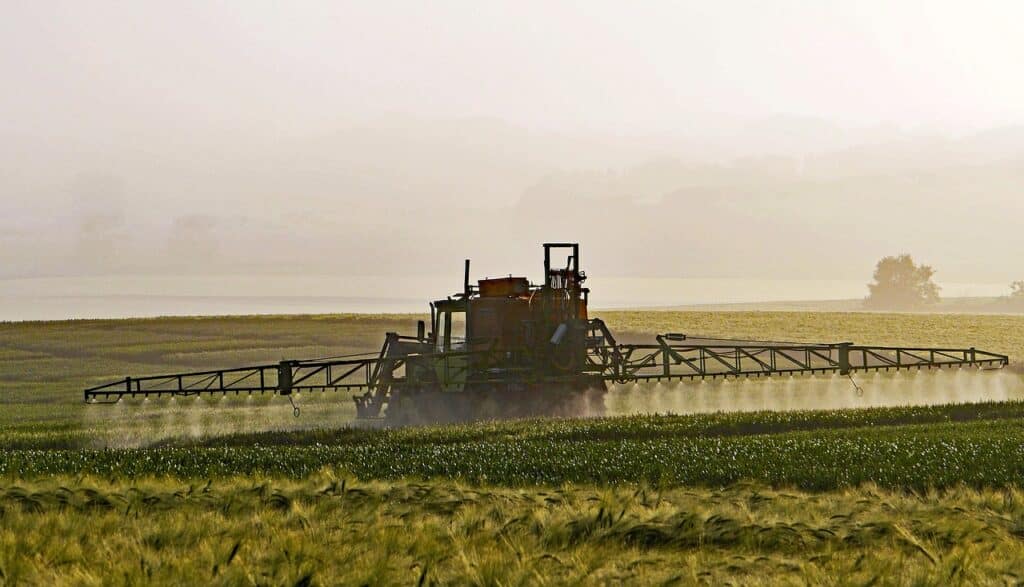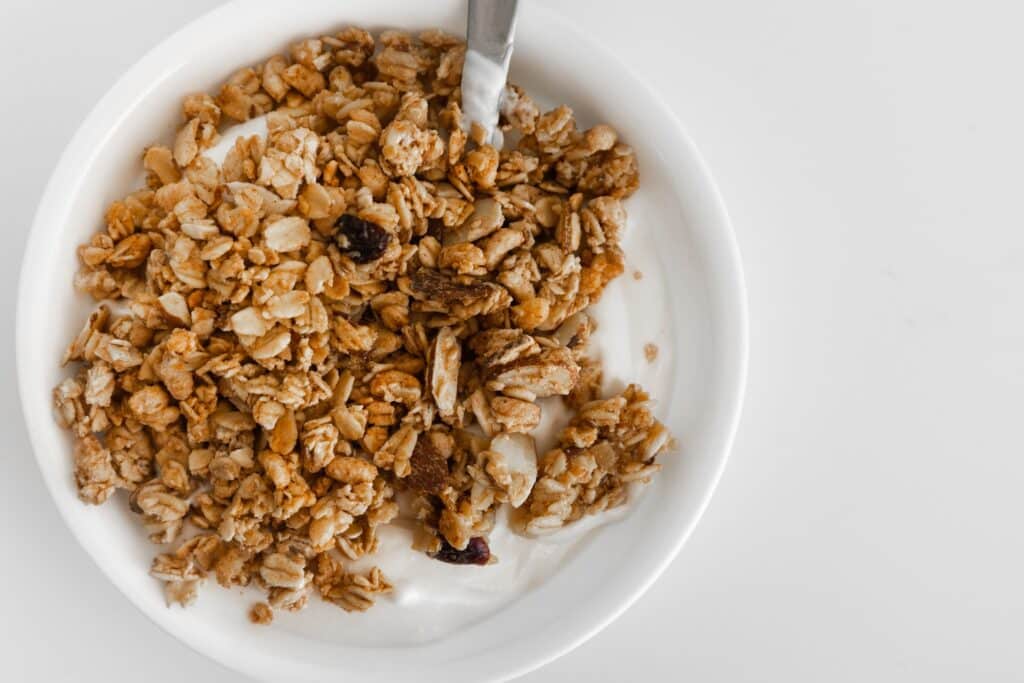Glyphosate is a common ingredient found in many weed killers. It’s believed that more than 80% of people in America come into contact with glyphosate. Learn about the foods that may have this chemical and ways to reduce your contact with it.
Key Facts
- 81% of people in America recently came into contact with glyphosate.
- Since the late 1970s, the amount of glyphosate used on crops has grown 100 times.
- Glyphosate-resistant crops were introduced in 1996, which has increased exposure.
- Roundup, the world’s most popular weed killer, contains this chemical.
- Bayer will stop selling Roundup in 2023 due to the potential health risks.
- Glyphosate has been found in more than 95% of the oat food samples tested.
All About Glyphosate
Glyphosate is the key chemical in herbicides like Roundup, a popular weed killer. When it was first sold in 1974, initial testing suggested that this glyphosate based herbicide (GBH) was quite safe for humans and other forms of life.
Because of these test results, many regulatory bodies worldwide set high limits for safe exposure to glyphosate. Since then, glyphosate use on crops has skyrocketed, leading to more people in America coming into contact with it. Today, it’s the most widely-used weed killer globally. In 1966, glyphosate-resistant crops were introduced, which also increased exposure.
Farmers depend on Roundup because it’s very effective at getting rid of weeds. These invasive plants can harm large crops. Crops resistant to glyphosate work by stopping an important plant growth enzyme, allowing farmers to specifically deal with the weeds.
Is Glyphosate Safe?
Simply put, we need more scientific research. Over the last 20 years, scientists have been studying the toxicity of glyphosate, but their findings aren’t always conclusive.
In 2016, the World Health Organization stated that glyphosate is “likely cancer-causing.” However, the Environmental Protection Agency insists that their scientists have found that “glyphosate probably doesn’t cause cancer in people.”
These very different conclusions make it hard to know what to believe. We need more research to make a determination.
Interestingly, Bayer, the company that owns Roundup, announced in 2021 that it would stop selling Roundup for use in homes and gardens in 2023. They said they made this decision because of the risks to agricultural workers and customers.
This announcement came two years after the company had to pay more than $80 million to a man who sued Roundup, claiming the chemical was the cause of his non-Hodgkin lymphoma.

Where Glyphosates Hide in Your Food
Traces of glyphosate herbicide can be found hidden in various food sources due to specific practices and ingredients. For instance, genetically modified (GMO) crops like high-fructose corn syrup, canola oil derived from GMO plants, and potatoes grown using herbicides may contain traces of glyphosate.
Additionally, glyphosate exposure can occur indirectly through the consumption of animal products, such as beef, derived from cows that are fed GMO corn, GMO soy, and GMO soy protein filler. Even wheat, a commonly consumed grain, may carry glyphosate residues if it has been treated with herbicides.
It is essential to be aware of these potential sources of glyphosate in our food supply and make informed choices to minimize dietary exposure.
Safest Pesticide-Free Foods
Each year, the Environmental Working Group compiles a list called the “Clean Fifteen,” which comprises the 15 fruits and vegetables with the lowest levels of pesticide residue, as per data from the USDA. Remarkably, nearly 70% of the samples analyzed from this list had no detectable pesticide residue.
For the year 2023, the Clean Fifteen includes the following items:
- Avocados
- Sweet corn
- Pineapple
- Onions
- Papaya
- Sweet peas (frozen)
- Asparagus
- Honeydew melon
- Kiwi
- Cabbage
- Mushrooms
- Mangoes
- Watermelon
- Sweet potatoes
- Carrots
By incorporating these cleaner and greener food options into your diet, you can significantly reduce your exposure to glyphosate herbicide and other pesticide residues.
Glyphosate-Contaminated Foods You Should Avoid
The presence of glyphosate in certain foods is a matter of concern and has been extensively studied. An investigation conducted by the Environmental Working Group yielded alarming results. It discovered that glyphosate, a widely used herbicide, was detected in more than 95% of commonly consumed oat-based food samples. Another subsequent study specifically focused on cereals marketed towards children, revealing that these products were among the most heavily contaminated with glyphosate.
The glyphosate level was measured in parts per billion (ppb), with a benchmark of 160 ppb established for children’s glyphosate intake. These findings underscore the need for further examination and effective measures to address glyphosate residues in our food supply.
Glyphosate in Children’s Foods
The Environmental Working Group evaluated the glyphosate level in popular cereals and snacks meant for children. They then compared these findings with their established safe benchmark for kids, which is set at 160 parts per billion (ppb)
- Honey Nut Cheerios, Medley Crunch — 833 ppb
- Nature Valley Crunch Granola Bars, Maple Brown Sugar — 566 ppb
- Nature Valley Granola Cups, Almond Butter — 529 ppb
Products with the Highest Glyphosate Level
Certain food products have been found to contain high levels of glyphosate, posing potential health risks. The most glyphosate-contaminated items identified include:
- Honey Nut Cheerios Medley Crunch (833 ppb)
- Nature Valley Crunchy Granola Bars, Maple Brown Sugar (566 ppb)
- Nature Valley Granola Cups, Almond Butter (529 ppb)
- Chocolate Peanut Butter Cheerios (400 ppb)
- Nature Valley Baked Oat Bites (389 ppb)
- Nature Valley Crunchy Granola Bars, Oats and Honey (320 ppb)
- Nature Valley Crunchy Granola Bars, Peanut Butter (312 ppb)
- Nature Valley Granola Cups, Peanut Butter Chocolate (297 ppb)
- Nature Valley Fruit & Nut Chewy Trail Mix Granola Bars, Dark Chocolate Cherry (275 ppb)
- Nature Valley Protein Granola, Oats and Dark Chocolate (261 ppb)
- Multi Grain Cheerios (216 ppb)
- Nature Valley Soft-Baked Oatmeal Squares, Blueberry (206 ppb)
- Fiber One Soft-Baked Cookies, Oatmeal Raisin (204 ppb)
- Nature Valley Granola, Peanut Butter Creamy & Crunchy (198 ppb)
- Nature Valley Biscuits with Almond Butter (194 ppb)
These findings emphasize the importance of carefully considering the potential glyphosate exposure associated with these food products and making informed choices to safeguard personal health.

How to Avoid Glyphosate Food Exposure
Knowing how to limit glyphosate in food helps you make smarter choices about what you eat. Here are four simple steps you can start with to reduce your glyphosate consumption.
1. Check for a “Glyphosate Residue Free” Label
The Detox Project has a process to officially confirm that products are free from glyphosate contamination. They use a trusted third-party lab to test products from manufacturers and farms to ensure there’s no glyphosate residue. Once they finish this process, the product gets a “Glyphosate Residue Free” certification that’s good for one year.
2. Check the List of “Glyphosate Residue Free” Products
Review The Detox Project’s list of “Glyphosate Residue Free” products before shopping. Not only will you get an idea of which products to avoid, but it’s also a good resource to find glyphosate-free alternatives to the products you’re already buying.
3. Choose Organic Food When You Can
Organic food is a good choice to avoid glyphosate. This is because certified organic food is grown without using herbicides or pesticides, including glyphosate. Eating organic food won’t solve the problem entirely, but it can help reduce glyphosate exposure. A recent study showed that people who ate only organic food for six days managed to lower the amount of glyphosate in their bodies by 70%.
4. Don’t Use Weed Killer on Your Food Crops
If you’re growing your own food, avoid using glyphosate-based herbicides like Roundup in your garden. There are plenty of alternatives to Roundup. Some organic products on the market work well, or you can even try making your own weed killer at home.
How to Clean Contaminated Produce
To effectively clean glyphosate-contaminated produce, follow these simple steps:
Begin by soaking the produce in a bowl containing two cups of cold water mixed with one teaspoon of baking soda. Allow the produce to soak for a minimum of 15 minutes.
After soaking, drain the produce in a colander and rinse it thoroughly under clean running water for one to two minutes. This step helps to remove any remaining residue.
Next, use paper towels to dry the produce, ensuring that any lingering contamination is wiped away.
If applicable, consider cutting or peeling the outer layer of the produce to further eliminate absorbed contaminants. Remember to discard the contaminated peels appropriately.
By following these guidelines, you can reduce the presence of glyphosate and promote safer consumption of your fruits and vegetables.
Protect Your Family from Glyphosate Exposure
In order to safeguard our well-being and that of our loved ones, it is crucial to remain informed and take necessary precautions against potential glyphosate toxicity. Although the definitive health risks of glyphosate in food have not been established, substantial evidence has emerged, leading to numerous lawsuits against Roundup, the widely used herbicide containing glyphosate. Legal actions aim to seek justice for individuals who have experienced harm as a potential consequence. By staying aware and prepared, we can better navigate the potential dangers associated with glyphosate exposure.
References
- https://www.centerforfoodsafety.org/press-releases/6421/monsanto-bayer-to-end-us-residential-sales-of-toxic-pesticide-glyphosate
- https://detoxproject.org/certification/glyphosate-residue-free/
- https://www.ehn.org/glyphosate-organic-food-2646939278.html
- https://www.epa.gov/ingredients-used-pesticide-products/glyphosate
- https://www.ewg.org/childrenshealth/monsanto-weedkiller-still-contaminates-foods-marketed-to-children
- https://www.ewg.org/news-insights/news/glyphosate-contamination-food-goes-far-beyond-oat-products
- https://www.fda.gov/food/pesticides/questions-and-answers-glyphosate
- https://www.greenmatters.com/p/monsanto-ordered-to-pay-dollar80-million-to-man-who-got-cancer-from-roundup
- https://www.iarc.who.int/featured-news/media-centre-iarc-news-glyphosate/
- https://www.ncbi.nlm.nih.gov/pmc/articles/PMC4756530/
- https://www.ncbi.nlm.nih.gov/pmc/articles/PMC8622992/
- https://www.sciencedirect.com/science/article/pii/S0160412022005475
